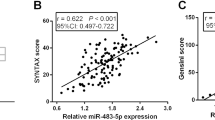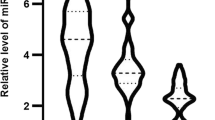Abstract
Aim
MicroRNA-497 (miR-497) directly targets fibroblast growth factor 23 (FGF23) to participate in the pathology of acute coronary syndrome (ACS) by regulating atherosclerosis, inflammatory response, lipid metabolism, etc. This study intended to investigate the dysregulation of the miR-497/FGF23 axis, and its association with the major adverse cardiovascular event (MACE) in female premature ACS.
Methods
MiR-497 and FGF23 from plasma samples were detected by RT-qPCR and ELISA in 979 newly diagnosed female premature ACS patients and 100 healthy controls (HCs). MACE was recorded during follow-up (median: 27.0, range: 1.0–54.0 months) in female premature ACS patients.
Results
MiR-497/FGF23 axis was reduced in female premature ACS patients versus HCs [median (interquartile range): 0.7 (0.1–1.2) versus 1.9 (1.1–3.4)] (P < 0.001). Meanwhile, miR-497 negatively correlated with FGF23 in femal e premature ACS patients (P < 0.001), but not in HCs (P = 0.157). In female premature ACS patients, the miR-497/FGF23 axis was negatively associated with serum creatinine (P < 0.001), serum uric acid (P = 0.003), high-sensitivity C-reactive protein (P < 0.001), total cholesterol (P = 0.031), and low-density lipoprotein cholesterol (P = 0.003). The 1-year, 2-year, 3-year, and 4-year accumulating MACE rate was 2.9%, 8.6%, 16.7%, and 26.0%, respectively. Interestingly, a high level of miR-497/FGF23 axis predicted decreased accumulating MACE risk (P < 0.001). After adjustment by multivariate Cox’s regression analysis, the high miR-497/FGF23 axis (hazard ratio (HR) = 0.005, P = 0.001) independently correlated with reduced accumulating MACE risk.
Conclusion
The plasma miR-497/FGF23 axis represents favorable kidney function, decreased inflammation, and reduced lipid level; meanwhile, this axis possesses prognostic value in predicting decreased accumulating MACE risk in female premature ACS patients.


Similar content being viewed by others
Data availability
The datasets generated during and/or analyzed during the current study are available from the corresponding author on reasonable request.
References
Tsao CW, Aday AW, Almarzooq ZI et al (2022) Heart disease and stroke statistics-2022 update: a report from the American Heart Association. Circulation 145(8):e153–e639. https://doi.org/10.1161/CIR.0000000000001052
Bhatt DL, Lopes RD, Harrington RA (2022) Diagnosis and treatment of acute coronary syndromes: a review. JAMA 327(7):662–675. https://doi.org/10.1001/jama.2022.0358
Roux S, Bhatt DL (2020) Self-treatment for acute coronary syndrome: why not? Eur Heart J 41(23):2144–2145. https://doi.org/10.1093/eurheartj/ehaa302
Agewall S (2021) Antiplatelet treatment in coronary syndrome. Eur Heart J Cardiovasc Pharmacother 7(2):81–82. https://doi.org/10.1093/ehjcvp/pvab015
Jia S, Liu Y, Yuan J (2020) Evidence in guidelines for treatment of coronary artery disease. Adv Exp Med Biol 1177:37–73. https://doi.org/10.1007/978-981-15-2517-9_2
Mehilli J, Presbitero P (2020) Coronary artery disease and acute coronary syndrome in women. Heart 106(7):487–492. https://doi.org/10.1136/heartjnl-2019-315555
Hao Y, Liu J, Liu J et al (2019) Sex differences in in-hospital management and outcomes of patients with acute coronary syndrome. Circulation 139(15):1776–1785. https://doi.org/10.1161/CIRCULATIONAHA.118.037655
Jones DE, Braun M, Kassop D (2020) Acute coronary syndrome: common complications and conditions that mimic ACS. FP Essent 490:29–34
Mohamed MO, Rashid M, Timmis A et al (2021) Sex differences in distribution, management and outcomes of combined ischemic-bleeding risk following acute coronary syndrome. Int J Cardiol 329:16–22. https://doi.org/10.1016/j.ijcard.2020.12.063
Haider A, Bengs S, Luu J et al (2020) Sex and gender in cardiovascular medicine: presentation and outcomes of acute coronary syndrome. Eur Heart J 41(13):1328–1336. https://doi.org/10.1093/eurheartj/ehz898
El-Menyar A, Ahmed E, Albinali H et al (2013) Mortality trends in women and men presenting with acute coronary syndrome: insights from a 20-year registry. PLoS ONE 8(7):e70066. https://doi.org/10.1371/journal.pone.0070066
Ricci B, Cenko E, Vasiljevic Z et al (2017) Acute coronary syndrome: the risk to young women. J Am Heart Assoc 6 (12). https://doi.org/10.1161/JAHA.117.007519
Kurpas A, Supel K, Idzikowska K, Zielinska M (2021) FGF23: a review of its role in mineral metabolism and renal and cardiovascular disease. Dis Markers 2021:8821292. https://doi.org/10.1155/2021/8821292
Chung CP, Chang YC, Ding Y et al (2017) alpha-Klotho expression determines nitric oxide synthesis in response to FGF-23 in human aortic endothelial cells. PLoS ONE 12(5):e0176817. https://doi.org/10.1371/journal.pone.0176817
Bockmann I, Lischka J, Richter B et al (2019) FGF23-mediated activation of local RAAS promotes cardiac hypertrophy and fibrosis. Int J Mol Sci 20(18). https://doi.org/10.3390/ijms20184634
Yamada S, Giachelli CM (2017) Vascular calcification in CKD-MBD: roles for phosphate, FGF23, and Klotho. Bone 100:87–93. https://doi.org/10.1016/j.bone.2016.11.012
Wang F, Ma R, Wang C (2022) Perioperative variation in serum FGF-23 level and its correlation with MACCE risk in unprotected left main coronary artery disease patients receiving coronary artery bypassing grafting. Front Surg 9:937342. https://doi.org/10.3389/fsurg.2022.937342
Huang SS, Huang PH, Leu HB et al (2021) Significance of serum FGF-23 for risk assessment of contrast-associated acute kidney injury and clinical outcomes in patients undergoing coronary angiography. PLoS ONE 16(7):e0254835. https://doi.org/10.1371/journal.pone.0254835
Xu L, Hu X, Chen W (2019) Fibroblast growth factor-23 correlates with advanced disease conditions and predicts high risk of major adverse cardiac and cerebral events in end-stage renal disease patients undergoing continuous ambulatory peritoneal dialysis. J Nephrol 32(2):307–314. https://doi.org/10.1007/s40620-018-0557-4
Cui J, Ren Z, Zou W, Jiang Y (2017) miR-497 accelerates oxidized low-density lipoprotein-induced lipid accumulation in macrophages by repressing the expression of apelin. Cell Biol Int 41(9):1012–1019. https://doi.org/10.1002/cbin.10808
Zhang D, Chen X, Zheng D (2022) A novel MIR503HG/miR-497-5p/CCL19 axis regulates high glucose-induced cell apoptosis, inflammation, and fibrosis in human HK-2 cells. Appl Biochem Biotechnol 194(5):2061–2076. https://doi.org/10.1007/s12010-021-03776-6
Liu D, Zhou S, Mao H (2020) MicroRNA-497/fibroblast growth factor-23 axis, a predictive indictor for decreased major adverse cardiac and cerebral event risk in end-stage renal disease patients who underwent continuous ambulatory peritoneal dialysis. J Clin Lab Anal 34(6):e23220. https://doi.org/10.1002/jcla.23220
Chinese Medical Association Emergency Physician Branch (2016) 2015 Guidelines for clinical practice of acute coronary syndrome in Chinese emergency department (Part II): diagnosis. Chin J Crit Care Med 36(1):9–11
Greenwood JP, Ripley DP, Berry C et al (2016) Effect of care guided by cardiovascular magnetic resonance, myocardial perfusion scintigraphy, or NICE guidelines on subsequent unnecessary angiography rates: the CE-MARC 2 randomized clinical trial. JAMA 316(10):1051–1060. https://doi.org/10.1001/jama.2016.12680
Chen JM, Zhong YT, Tu C, Lan J (2020) Significance of serum fibroblast growth factor-23 and miR-208b in pathogenesis of atrial fibrillation and their relationship with prognosis. World J Clin Cases 8 (16):3458–3464. https://doi.org/10.12998/wjcc.v8.i16.3458
Akin F, Celik O, Ayca B et al (2015) Associations of fibroblast growth factor 23 and fetuin-A with coronary plaque burden and plaque composition in young adults. J Investig Med 63(4):613–619. https://doi.org/10.1097/JIM.0000000000000153
Xiao Y, Zhang X, Fan S et al (2016) MicroRNA-497 inhibits cardiac hypertrophy by targeting Sirt4. PLoS ONE 11(12):e0168078. https://doi.org/10.1371/journal.pone.0168078
Chen T, Zhang X, Qian W et al (2022) Serum miR-497-5p serves as a diagnostic biomarker for acute coronary syndrome and predicts the occurrence of major adverse cardiovascular events after percutaneous coronary intervention. Bioengineered 13(4):8266–8276. https://doi.org/10.1080/21655979.2022.2051885
Cao Z, Wang H, Zhu X (2021) The role of serum miR-497 on the predictive index of early diagnosis and poor prognosis of atherosclerosis cerebral infarction. Iran J Public Health 50 (5):927–937. https://doi.org/10.18502/ijph.v50i5.6110
Scialla JJ, Wolf M (2014) Roles of phosphate and fibroblast growth factor 23 in cardiovascular disease. Nat Rev Nephrol 10(5):268–278. https://doi.org/10.1038/nrneph.2014.49
Jafarzadeh M, Mohammad Soltani B, Ekhteraei Tousi S, Behmanesh M (2018) Hsa-miR-497 as a new regulator in TGFbeta signaling pathway and cardiac differentiation process. Gene 675:150–156. https://doi.org/10.1016/j.gene.2018.06.098
Zhang M, Yang D, Yu H, Li Q (2021) MicroRNA-497 inhibits inflammation in DSS-induced IBD model mice and lipopolysaccharide-induced RAW264.7 cells via Wnt/beta-catenin pathway. Int Immunopharmacol 101 (Pt B):108318. https://doi.org/10.1016/j.intimp.2021.108318
Wu K, Tao G, Xu T et al (2021) Downregulation of miR-497-5p prevents liver ischemia-reperfusion injury in association with MED1/TIMP-2 axis and the NF-kappaB pathway. FASEB J 35(4):e21180. https://doi.org/10.1096/fj.202001029R
Wang J, Zhao SM (2021) LncRNA-antisense non-coding RNA in the INK4 locus promotes pyroptosis via miR-497/thioredoxin-interacting protein axis in diabetic nephropathy. Life Sci 264:118728. https://doi.org/10.1016/j.lfs.2020.118728
Wu X, Weiszmann J, Ge H et al (2012) A unique FGF23 with the ability to activate FGFR signaling through both alphaKlotho and betaKlotho. J Mol Biol 418(1–2):82–89. https://doi.org/10.1016/j.jmb.2012.02.027
Takashi Y, Kawanami D (2022) The role of bone-derived hormones in glucose metabolism, diabetic kidney disease, and cardiovascular disorders. Int J Mol Sci 23(4). https://doi.org/10.3390/ijms23042376
Rodriguez-Ortiz ME, Diaz-Tocados JM, Munoz-Castaneda JR et al (2020) Inflammation both increases and causes resistance to FGF23 in normal and uremic rats. Clin Sci (Lond) 134(1):15–32. https://doi.org/10.1042/CS20190779
Mace ML, Olgaard K, Lewin E (2020) New aspects of the kidney in the regulation of fibroblast growth factor 23 (FGF23) and mineral homeostasis. Int J Mol Sci 21(22). https://doi.org/10.3390/ijms21228810
Degirolamo C, Sabba C, Moschetta A (2016) Therapeutic potential of the endocrine fibroblast growth factors FGF19, FGF21 and FGF23. Nat Rev Drug Discov 15(1):51–69. https://doi.org/10.1038/nrd.2015.9
Musgrove J, Wolf M (2020) Regulation and effects of FGF23 in chronic kidney disease. Annu Rev Physiol 82:365–390. https://doi.org/10.1146/annurev-physiol-021119-034650
Lang F, Leibrock C, Pandyra AA et al (2018) Phosphate homeostasis, inflammation and the regulation of FGF-23. Kidney Blood Press Res 43(6):1742–1748. https://doi.org/10.1159/000495393
Zhao Y, Zhang J (2021) Clinical implication of homocysteine in premature acute coronary syndrome female patients: its distribution and association with clinical characteristics and major adverse cardiovascular events risk. Medicine (Baltimore) 100(18):e25677. https://doi.org/10.1097/MD.0000000000025677
Author information
Authors and Affiliations
Corresponding author
Ethics declarations
Ethics approval
Approval from the Ethics Committee of our hospitals was gained.
Consent to participate
Written informed consent from all subjects was obtained.
Consent to publish
Not applicable.
Competing interests
The authors declare no competing interests.
Additional information
Publisher's Note
Springer Nature remains neutral with regard to jurisdictional claims in published maps and institutional affiliations.
Supplementary Information
Below is the link to the electronic supplementary material.
Rights and permissions
Springer Nature or its licensor (e.g. a society or other partner) holds exclusive rights to this article under a publishing agreement with the author(s) or other rightsholder(s); author self-archiving of the accepted manuscript version of this article is solely governed by the terms of such publishing agreement and applicable law.
About this article
Cite this article
Jiang, Y., Cai, W., Cai, G. et al. The dysregulation of plasma miR-497/FGF23 axis, and its association with clinical characteristics and major adverse cardiovascular event in female premature acute coronary syndrome patients. Ir J Med Sci 192, 2105–2115 (2023). https://doi.org/10.1007/s11845-022-03256-8
Received:
Accepted:
Published:
Issue Date:
DOI: https://doi.org/10.1007/s11845-022-03256-8




